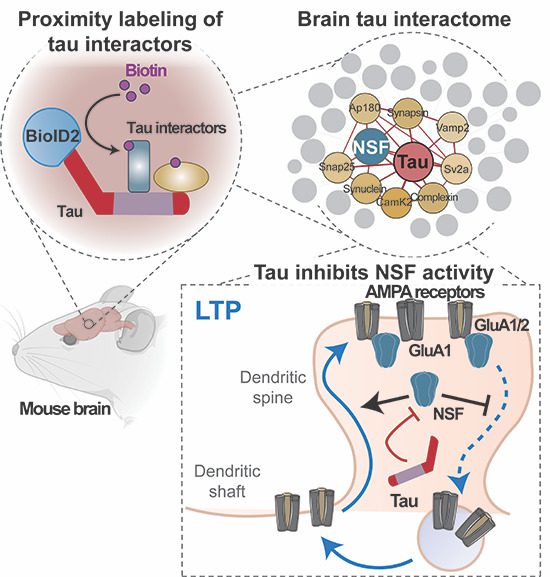According to new research from Flinders University, the tau protein, which plays a critical role in the development of Alzheimer’s disease, is also involved in normal learning processes in the healthy brain, potentially providing a target for future drug therapies.

The researchers discovered that the tau protein, whose role has long been unknown, may aid in molecular processes of memory formation. The research findings were published in The EMBO Journal.
Protein associated with microtubules Tau protein is a key player in Alzheimer’s disease and other tauopathies. The physiological functions of tau, on the other hand, are unknown.
The researchers applied a sensitive method known as proximity labeling to identify all proteins with which tau interacts within brain cells, labeling and identifying the entire collection of interacting proteins as they went.
Tau interactors map onto cytoskeletal, synaptic vesicle, and postsynaptic receptor regulation pathways, and they are significantly enriched in Parkinson’s, Alzheimer’s, and prion disease.
When the researchers examined the proteins that interact with tau and the specific functions that these interactions support, they discovered that while tau binds to proteins that support brain cell structure, it also interacts with proteins that control vesicles and cell surface receptors for neurotransmitters, both of which are required for learning and memory in the brain.
According to Dr. Arne Ittner, Senior Research Fellow in Neuroscience at the Flinders Health and Medical Research Institute and the paper’s senior author, this new study took a snapshot of all interacting partners tau interacts with to support the normal functioning of the brain.
The researchers identified one enzyme that controls neurotransmitter sensors from a large group of interacting partners. This enzyme, known as N-maleimide sensitive factor (NSF), is inhibited by tau, especially in Alzheimer’s.
Changes in the connections between brain cells, known as synapses, underpin the processes involved in memory formation and retention. These changes occur at the molecular level, and aid in storing and retrieving memories, such as locations visited or loved ones.
When memories form, the number of neurotransmitter receptors in synapses increases (sensor molecules that detect messages from other brain cells). Several factors influence this process, including the enzyme ‘N-maleimide sensitive factor.
While neuropathologists have known about the end-stages of Alzheimer’s disease for over a century, it was less clear how normal tau functions may link to memory impairment at other stages of life. The new study pinpoints one such starting point’ where things can go wrong.
According to Emmanuel Prikas, study lead author and Flinders University Ph.D. student, the effects of tau protein in dementia-related memory loss are well known, but what’s interesting to see is that tau helps control normal memory processes.
After identifying NSF as a new tau partner, the researchers used high-powered microscopic techniques and mouse memory testing to investigate how tau specifically contributes to processes involving receptors for the neurotransmitter glutamate.
The research team worked in collaboration with Macquarie University colleagues to confirm how tau affected NSF in cultured brain cells, the researchers discovered that NSF was uncontrolled in cells lacking the tau protein, resulting in abnormal glutamate receptor behavior.
By removing and reintroducing the tau protein in brain cells, the researchers were able to attribute changes in receptor behavior to tau changes, which may become focal points for future drug therapies, says Dr. Ittner.
Notably, the neurotransmitters glutamate and tau have previously been linked to seizures and stroke. As a result, the new findings establish a molecular link between tau’s normal function in controlling glutamate receptors in the brain and conditions of increased brain activity.
According to Dr. Ittner, mutations in NSF have been linked to hereditary forms of epilepsy, putting this new discovery in close proximity to tau’s function in epilepsy and stroke.
The findings map tau interactomes in neurons and establish a functional link between tau and NSF in plasticity-associated AMPAR trafficking and memory.
Story Source: Reference Paper | Reference Article
Learn More:
Top Bioinformatics Books ↗
Learn more to get deeper insights into the field of bioinformatics.
Top Free Online Bioinformatics Courses ↗
Freely available courses to learn each and every aspect of bioinformatics.
Latest Bioinformatics Breakthroughs ↗
Stay updated with the latest discoveries in the field of bioinformatics.
Dr. Tamanna Anwar is a Scientist and Co-founder of the Centre of Bioinformatics Research and Technology (CBIRT). She is a passionate bioinformatics scientist and a visionary entrepreneur. Dr. Tamanna has worked as a Young Scientist at Jawaharlal Nehru University, New Delhi. She has also worked as a Postdoctoral Fellow at the University of Saskatchewan, Canada. She has several scientific research publications in high-impact research journals. Her latest endeavor is the development of a platform that acts as a one-stop solution for all bioinformatics related information as well as developing a bioinformatics news portal to report cutting-edge bioinformatics breakthroughs.






